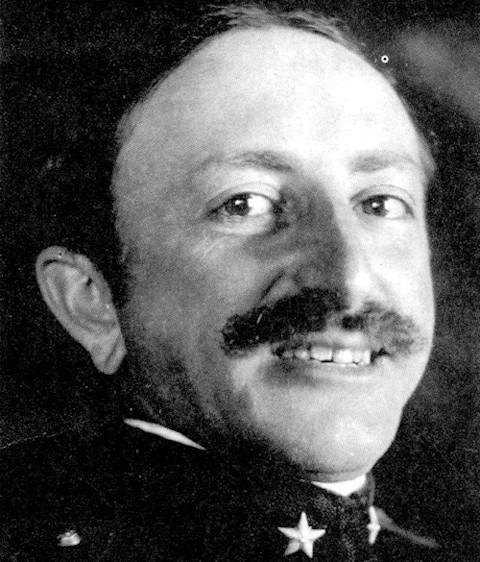Angelo Belloni, naval officer, submariner, designer, experimenter of innovative naval equipment. Director of the courses of the diving school and technical consultant of the Royal Navy. An extrovert and brilliant man who has devoted a large part of his life to the development of underwater vehicles.
He was above all one of those extraordinary characters who led a life full of events and adventures.
From 1904 to 1948 he published a significant number of articles on the "Rivista Marittima" technical-scientific information body of the Navy since 1868.
Angelo Belloni was born in Pavia on March 4, 1882 to Cesare and Aurelia Rossi della Volta. He attended elementary schools in Pavia and higher studies at the Beccaria High School in Milan, therefore, attracted by the sea in 1899, he applied for admission to the Naval Academy of Livorno, but was rejected at the medical examination for thoracic deficiency.
Determined to enter the Academy, he returned to Pavia and enrolled at the University in the first year of mathematics, also earning a post as a student at the prestigious Collegio Ghislieri founded by Pope Pius V (1504-1572), whose figure is linked to the establishment of the League Santa and the victorious Battle of Lepanto (1571), and Canottieri Ticino the oldest rowing company in Pavia and one of the oldest in Italy.
Founded in 1873 as a rowing company, Canottieri Ticino currently occupies an area of about 10 hectares within the Ticino Park and boasts 680 members.
He rowed on Ticino like a madman in summer and winter with the "yole a quattro" (rowing wooden boat, fast and with a slim shape) of the university championship crew, or alone with the "sandolino "(Very small boat long and narrow, flat-bottomed, where only a rowing machine sits, equipped with an oar to the batten, which is grasped with two hands for the central part and is immersed in the water alternately to starboard and left, without resting it on any rowlock) full days on the water.

In one year the circumference of his chest increases by 14 centimeters and so, having returned to Livorno in 1900, he is admitted to attend the Academy. After three years of study, he finished second in his course after Giancarlo Vallauri (1882-1957), always first in the three years of the course.
In early February 1904 the Marco Polo he leaves for the Far East and the young Belloni visits China, Korea and Japan. It is said that boarding on the Marco Polo and the departure to the East is due to the mother, worried about Angelo's falling in love with a theater actress. With the help of Carlo Mirabello (1847-1910), then Minister of the Navy and brother of a friend of his mother, his boarding on that unit was urgently obtained.
Between 1917 and 1918 the Marco Polo, now incapacitated for active service, was converted into troop transport in the Arsenale of Venice. On leaving the shipyard, on 4th April 1918, 1st class subsidiary ship was reclassified with the name of Cortellazzo and sent to Dalmatia. On September 12, 1919 the unit, contrary to the orders received, joined the enterprise of Fiume by Gabriele d'Annunzio, and on October 1, 1920 was renamed Europe. When she returned to Italy, on 16 January 1921 she was disarmed.
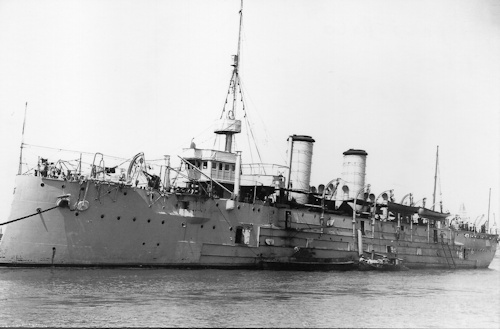 Having his crew contravened under the orders of the Navy General Staff, in order to cancel his memory on the same day he was re-registered with the name of Alessandro Volta (photo).
Having his crew contravened under the orders of the Navy General Staff, in order to cancel his memory on the same day he was re-registered with the name of Alessandro Volta (photo).
With the 'Elba arrives in Shanghai and on Puglia reaches Korea and Japan, where he witnessed the recovery of the Russian cruiser Varyag which made its underwater debut. Speaking, the Japanese boarded the ship and asked for permission to visit and photograph it, then sending a report to the Ministry that the captain of the Puglia sent to Rome. Receiving a eulogy from the minister Mirabello and the publication of the report on the "Maritime Magazine".
Il Varyag participated in one of the first battles of the Russo-Japanese war of 1904-1905 in the Korean port of Chemulpo (now Inchon), reporting serious losses. By decision of the commander the cruiser was sunk. In 1905, it was brought back to the surface and subsequently placed in the museum in Korea. On 11 November 2010 at the Russian embassy in Seoul, in the presence of Russian President Medvedev, the bow flag of the Varyag has been permanently transferred to Russia. After the handover ceremony, the flag was hoisted aboard a missile cruiser Varangian.
In Shanghai, thanks to her experience as "Ticino" vests, she composes a team of 14 men, intense training, steaks and eggs every day for the crew, leading her to victory in a regatta against American soldiers on boardOregon.
Returning to Italy from 1905, he embarked on ships Morosini, Saint Bon e Benedetto Brin. In 1909 he studied and patented the first aiming device with independent aiming line and in 1910 he was sent first to Brindisi and then to the Officina Siluri of San Bartolomeo della Spezia. Aggregate to the testing mission of the new Whitehead hot air torpedoes, he is sent to Rijeka, where he joins irredentist, Italian and Slavic students, ardently passionate about their cause.
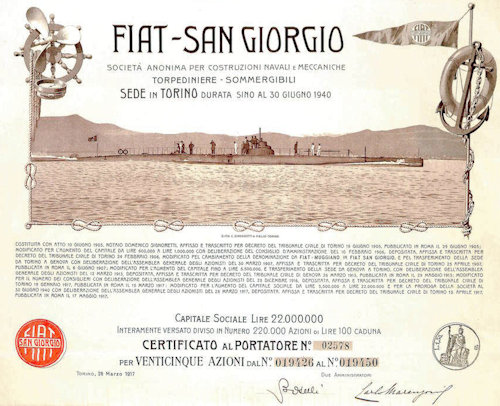 Due to a severe form of otitis with consequent deafness, he was placed on leave on September 16, 1911. He is only twenty-nine years old. Left with regret the Royal Navy, he is hired by Fiat-San Giorgio and in charge of the tests and delivery of the submarines that the Muggiano shipyard builds for foreign naval forces.
Due to a severe form of otitis with consequent deafness, he was placed on leave on September 16, 1911. He is only twenty-nine years old. Left with regret the Royal Navy, he is hired by Fiat-San Giorgio and in charge of the tests and delivery of the submarines that the Muggiano shipyard builds for foreign naval forces.
The first submarine built at the Muggiano was the Foca launched in 1907, which was followed in 1908 by two other boats, built for Sweden and Denmark designed by the director of the plant, the engineer Cesare Laurenti (1865-1921). These submarines, equipped with petrol engines for surface navigation, gave brilliant results. The company quickly acquired worldwide reputation by building submarines for Italy, Brazil, Portugal, England, Japan, Russia, Sweden and Holland.
In 1917 the construction of submarines required an increase in resources and personnel and "FIAT San Giorgio" purchased the shipyard belonging to the company "Cantieri Navali Riuniti" incorporating its production capacities.
Lit interventionist during the phase of Italian neutrality, iOn October 4, 1914, he performed a real piracy act by taking possession, together with about fifteen sailors convinced of participating in a secret mission, of a coastal submarine built in the Muggiano shipyards and destined for the Russian Navy (the unit was only marked from the construction code, F-43, if it had been delivered it would have had the name of Svyatoi Georgjy; launched on July 5, 1914, it would then have been requisitioned by the Royal Navy and entered in the framework of the military ship with the name of Argonaut (Photo). The name of a cephalopod belonging to the genus of marine molluscs, but also reminds us of the mythical Argonauts, daring Greek navigators narrated in the work "The Argonautics" by Apollonio Rodio.
Belloni's idea was to attack units of the Austro-Hungarian imperial war navy thus forcing Italy to enter the war. The attempt failed, also because Belloni first went to Corsica to stock up on torpedoes and seek support from the French Navy, which, after hearing the Italian authorities, stopped the boat in Ajaccio. The Ministry ordered immediate investigations to the Admiral commander-in-chief of the Department and the start of an investigation which will lead to the opening of a criminal file to the Sarzana Court, competent for the territory (at the time the Court had not yet been based in La Spezia ).
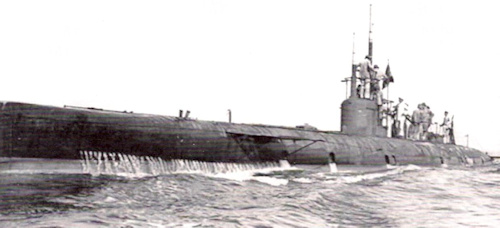 Also because the owner of the company, lawyer Giovanni Agnelli, also filed a complaint against Belloni for the serious damage caused to Fiat-San Giorgio. The process was based not only on Belloni, but also on the site's administrative director, cavalier Giuseppe Boselli and on the technical one, Cesare Laurenti, who was subsequently cleared in the preliminary investigation. Arrested, Belloni was tried on charges of "submarine theft" and twelve other charges. In normal times he would have been sentenced, but Italy's entry into the war and his undoubted abilities convinced the judges of the military tribunal to acquit him with full formula.
Also because the owner of the company, lawyer Giovanni Agnelli, also filed a complaint against Belloni for the serious damage caused to Fiat-San Giorgio. The process was based not only on Belloni, but also on the site's administrative director, cavalier Giuseppe Boselli and on the technical one, Cesare Laurenti, who was subsequently cleared in the preliminary investigation. Arrested, Belloni was tried on charges of "submarine theft" and twelve other charges. In normal times he would have been sentenced, but Italy's entry into the war and his undoubted abilities convinced the judges of the military tribunal to acquit him with full formula.
Upon Italy's entry into the war, the high ranks of the Royal Navy forgot his hearing defects and called him back to service with the rank of second lieutenant in the vessel. Convinced of the importance of the submersible vessel and of the military potential inherent in diving equipment, he soon became a supporter of the submarine weapon, so much so as to be destined for the new specialty.
In 1915 he was given command of the pocket submarine A-1. During the conflict he participated in 112 missions, therefore, from 1918 to 1925 he participated first in war missions in undeveloped areas, then remaining in the Upper Adriatic for long periods of work or serving in the offices of Venice and Pula. On October 1, 1925, he joined the Submarine Division, participating in normal training activities and in launch and attack competitions. It ceased trading on March 23, 1928.
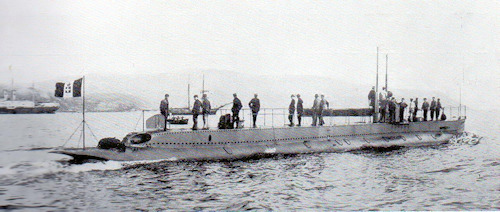 So far his career in the Royal Navy, but Belloni is also remembered for giving life to the body of the underwater raiders. On November 27, 1917, while he was returning to the base after a mission, the submarine Galileo Ferraris (photo) ran aground a couple of miles north of the mouth of the Po di Gnocca. Once towed to La Spezia, after assessing the damage, it was decided to proceed with the disarming of the vehicle. However, Belloni managed to convince the Navy's leaders to use the submarine as an "approach" means for the raiders.
So far his career in the Royal Navy, but Belloni is also remembered for giving life to the body of the underwater raiders. On November 27, 1917, while he was returning to the base after a mission, the submarine Galileo Ferraris (photo) ran aground a couple of miles north of the mouth of the Po di Gnocca. Once towed to La Spezia, after assessing the damage, it was decided to proceed with the disarming of the vehicle. However, Belloni managed to convince the Navy's leaders to use the submarine as an "approach" means for the raiders.
So in February 1919 the Ferraris, under Belloni's command, began a series of tests in the waters between La Spezia and Palmaria. Once the available economic resources were exhausted, the Royal Navy shaved the submarine on December 15, 1919.
Passion and skills, however, could not keep Belloni away from his beloved underwater world, so when he learned that the Ferraris would have been disbarred, seized the opportunity and - again with the support of Admiral Thaon di Revel (1859-1948), the former governor of Eritrea Giuseppe Salvago Raggi (1866-1946) and Commendatore Aldo Borletti (one of the three brothers Borletti Lombard entrepreneurs who signed him a check for one hundred thousand lire) - managed to convince the Minister of the Navy, Admiral Giovanni Sechi (1871-1949) to sell him the submarine.
Il Galileo Ferraris, was registered in the Italian Capitanerie as a "commercial submarine". Naturally, some doubts arise about the real purpose of Belloni's initiative and the availability of the Regia Marina: the concession to a private individual of a submarine was truly unusual. the British obviously also had, when the Ferraris he stopped first in Port Said and then in Port Sudan.
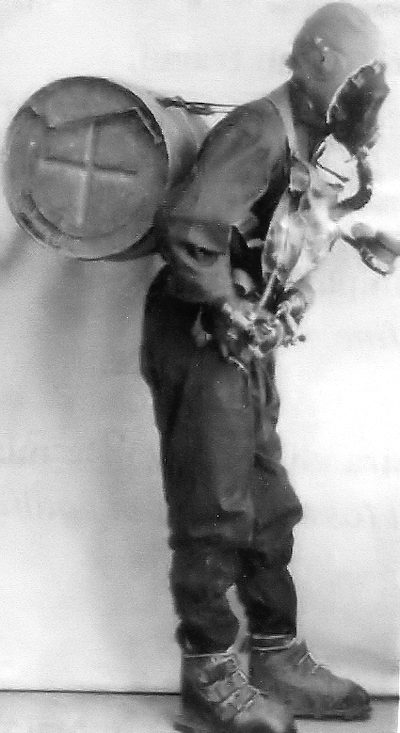 With the company Ferraris, Belloni obtained from the Regia Marina for rent, with the right to purchase, also two lookouts, the Cerboli from 280 tons and the Fortune from 340, (it should be the former Norwegian merchant ship Lionel Jacobsen, launched in 1912. Purchased by the Royal Navy and entered service in 1916, it was expelled in 1919). Both were registered as "piropescherecci". These units were supposed to play the role of support units for the submarine in the new activity that Belloni intended to undertake: that of the search for pearl banks and pearl fishing in the Red Sea.
With the company Ferraris, Belloni obtained from the Regia Marina for rent, with the right to purchase, also two lookouts, the Cerboli from 280 tons and the Fortune from 340, (it should be the former Norwegian merchant ship Lionel Jacobsen, launched in 1912. Purchased by the Royal Navy and entered service in 1916, it was expelled in 1919). Both were registered as "piropescherecci". These units were supposed to play the role of support units for the submarine in the new activity that Belloni intended to undertake: that of the search for pearl banks and pearl fishing in the Red Sea.
His intention was that the Ferraris leaned on the bottom, allowing some crew members, wearing a sort of rubberized and waterproof fabric sheath, equipped with a hood with eyepieces, what was then called "Belloni dress" (photo), to exit the hull through a watertight compartment and, walking on the bottom, identify the pearl banks. But the hostility of the fishermen, the scarcity of the benches and the bad quality of the pearls, convinced Belloni to abandon the project.
Dahlak pearl fishing had affected a Frenchman, Henry de Monfreid, a dozen years earlier. He too failed in the venture.
He therefore decided to use the Ferraris in the recovery of the wrecks and for this purpose he obtained a pontoon and two lookouts from the Royal Navy. But even this initiative did not have great success. In mid-1921 the submarine was partially demolished and the proceeds from the sale of its engine and a few other equipment, as well as that of the Cerboli, goes partly to the Navy itself and partly to cover the crew's return costs to Italy.
Albeit with considerable delay, Belloni's ideas propagated since 1914 in conferences and writings, made their way. His reputation as a skilled technician was so well known that in 1940, despite being 58 years old, the Regia Marina called him back to service entrusting him with the direction of the school for the training of divers. Together with the major of the naval genius Teseo Tesei (1909-1941), they laid the foundations of the X Flotilla Mas.
Without Belloni, his inventions and his insistence on setting up the school of divers, the courageous undertakings made by the operators of the X Mas, would not have been possible.
Belloni's original idea of employing underwater spoilers who, escaping from a submarine, could walk on the bottom carrying on their shoulders an explosive charge to be placed under the hulls of the enemy ships had, in fact, been changed, providing for the use of underwater swimmers who , always coming out of a submerged submerged or from special compartments obtained in the hull of a ship they managed to get close to the objectives and to hook explosive trunks to the anti-roll fins of the enemy ships.
With the improvement of the means, there were striking successes such as that of the Baia di Suda (25-26 March 1941, in which another Pavese Angelo Cabrini participated), and the undertaking of Alexandria in Egypt on 19 December 1941, which deprived the Royal Navy of its battleships in the Mediterranean.
With the armistice of 8 September 1943 the X Mas Flotilla, under the command of Junio Valerio Borghese (1906-1974), remained largely blocked in La Spezia, where it reorganized itself into a free body, then entered the Navy of the Republic of Salo.
Belloni joins the Social Republic, assuming the role of "Technical Consultant" and commander of the squadron of three small submarines "CA". On May 25, 1944, he was involved in a traffic accident which blocked him for nine months in various military hospitals.
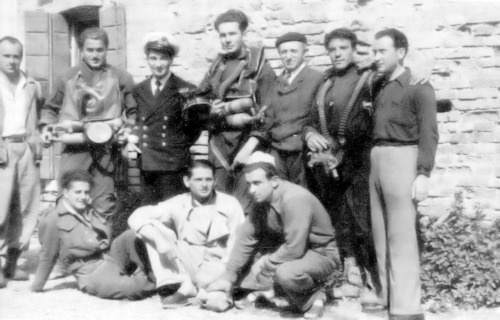 On March 10, 1945 he obtained from Borghese to resume service at the "Bocca Serchio" Divers Center in Sant'Andrea (Venice). The war ends, Belloni (in the photo the fifth from the left) is arrested by the partisans and imprisoned in the prison of S. Maria Maggiore, with many others of the X Flotilla Mas.
On March 10, 1945 he obtained from Borghese to resume service at the "Bocca Serchio" Divers Center in Sant'Andrea (Venice). The war ends, Belloni (in the photo the fifth from the left) is arrested by the partisans and imprisoned in the prison of S. Maria Maggiore, with many others of the X Flotilla Mas.
Elements left in the south, together with numerous prisoners released from allied prison camps, reorganized the unit with the new name of "Mariassalto", based in Taranto and commanded by the frigate captain Ernesto Forza (1900-1975). This unit participated in actions alongside the allied units, such as that carried out on the night of June 21, 1944 in the port of La Spezia which led to the sinking of the heavy cruiser Bolzano, last survivor of its class, and further damage to the cruiser Gorizia, already under repair for the damage suffered in a bombing. The regiment's NP (Swimmers Paratroopers) department was also part of this group Saint Mark, which carried out numerous infiltration operations behind enemy lines, disembarking from Italian MAS or submarines. THE Paratroopers swimmers they were the first allied ward to enter Venice on April 30, 1945.
In 1954 the group was reconstituted with the name of Comsubin (Incursori Underwater Command), based in Varignano di La Spezia.
On 8 May 1945 he was freed and saved from shooting by the commander Lionel Buster Crabb (1909-1956), creator of the English frogmen and a leading figure in the Royal Navy. He had created the insidious anti-means in Gibraltar, which had caused the death of Licio Visintini (1915-1942) and Giovanni Magro (1916-1942).
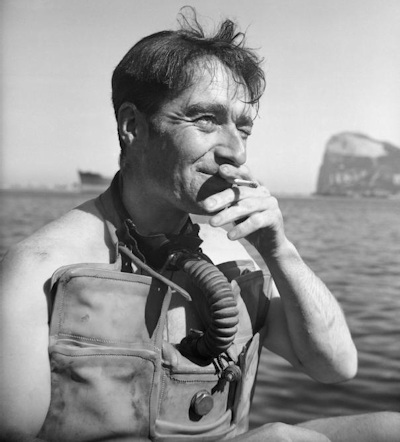 MI6 recruited Commander Crabb (photo) in 1956 to investigate the Soviet cruiser Ordzhonikidzeche who had Nikita Khrushchev (1894-1971) and Nikolai Bulganin (1895-1975) on board on a diplomatic mission in Great Britain. According to Peter Wright in his book "Spycatcher" published in 1987, Crabb was sent to investigate the propeller of theOrdzhonikidze, a new design that the British services wanted to examine. On April 19, 1956, Crabb dived into Portsumouth harbor leaving forever. Ten days later, British newspapers published stories of Crabb's disappearance on an underwater mission. English diving expert Rob Hoole wrote in 2007 that Crabb had probably died of oxygen poisoning or carbon dioxide poisoning and that Crabb's age and bad health from his heavy drinking and smoking had made him unsuitable for mission that had been assigned to him.
MI6 recruited Commander Crabb (photo) in 1956 to investigate the Soviet cruiser Ordzhonikidzeche who had Nikita Khrushchev (1894-1971) and Nikolai Bulganin (1895-1975) on board on a diplomatic mission in Great Britain. According to Peter Wright in his book "Spycatcher" published in 1987, Crabb was sent to investigate the propeller of theOrdzhonikidze, a new design that the British services wanted to examine. On April 19, 1956, Crabb dived into Portsumouth harbor leaving forever. Ten days later, British newspapers published stories of Crabb's disappearance on an underwater mission. English diving expert Rob Hoole wrote in 2007 that Crabb had probably died of oxygen poisoning or carbon dioxide poisoning and that Crabb's age and bad health from his heavy drinking and smoking had made him unsuitable for mission that had been assigned to him.
Knowing his skills and his great experience, Captain Crabb will want him as a collaborator in the demining of Italian ports. An "Experimental Underwater Station" was born in the Fort of Sant'Andrea. Belloni is named "Technical Adviser" of the "Allied Navies Experimental Station", he develops new self-contained breathing apparatus, dedicating himself with some "Gamma" men to the arduous task of demining the Lagoon.
A year later, on July 1, 1946, the Allies left Sant'Andrea and handed over the "Experimental Station" to the Italian Navy. Belloni will remain in force as a Technical Consultant, making all his experience in the field available to Maricentrosub, as well as his documentation of 35 years of diving activity.
He was discharged from the Navy with the rank of corvette captain. Collaboration continued with Pirelli, which had taken over its main patents, and thanks to the rights of invention, it was able to live with dignity and turn its attentions, with over half a century in advance, to the energy sources linked to the sea and the sun, designing an ondo-hydroelectric power station, an underwater turboelectric power station and a sea-powered distiller operated by the sun.
He spent the last eleven years of his life in the Frugone di Cavi di Lavagna castle.
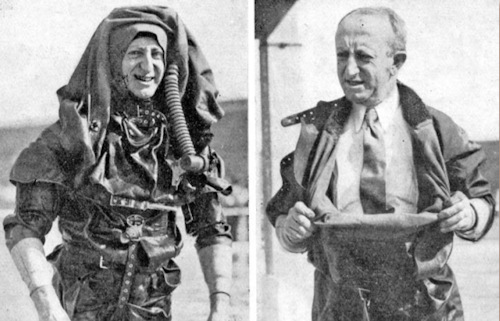 Belloni, who had managed to survive two world wars, died on March 9, 1957, in Genoa, overwhelmed by a tram while heading to a conference of submarines. Absorbed in his thoughts and made almost deaf by the underwater experiments in which he had often acted as a guinea pig so as not to endanger the lives of others, he did not notice the arrival of the medium which, in turn, could not avoid it. In this way, "banal and earthly" disappeared at 75; an exceptional man for inventiveness, character, fortitude and dedication to the Navy.
Belloni, who had managed to survive two world wars, died on March 9, 1957, in Genoa, overwhelmed by a tram while heading to a conference of submarines. Absorbed in his thoughts and made almost deaf by the underwater experiments in which he had often acted as a guinea pig so as not to endanger the lives of others, he did not notice the arrival of the medium which, in turn, could not avoid it. In this way, "banal and earthly" disappeared at 75; an exceptional man for inventiveness, character, fortitude and dedication to the Navy.
The image of an elderly gentleman who, in the immediate post-war period, continued undaunted to immerse himself in the cold waters of the channel in front of the island of Palmaria to experiment with his innovative instruments was still alive in the memory of the old fishermen of Porto Venere.
The "Commander", as he was called by the inhabitants of the country, was often accompanied in his experiments at sea by a real team of small divers. These were the seven children he had from Gabriella Vinassa de Regny, daughter of Paolo Vinassa de Regny (1871-1957), geologist and professor also in our University of Pavia, of which he was also Rector, whom Belloni had married in October 1920.
Photo: Navy / web / Royal Navy

